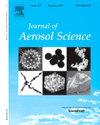Evaluating total outward leakage of face-worn products across various particle sizes for source control against submicron aerosols: Implications for public health protection
IF 3.9
3区 环境科学与生态学
Q2 ENGINEERING, CHEMICAL
引用次数: 0
Abstract
During COVID-19, the general public widely used face-worn products (FwPs) to mitigate viruses spread via airborne transmission. This study investigated the effectiveness of various FwP categories in reducing submicron aerosol transmission by evaluating total outward leakage (TOL) across particle sizes. Nine FwP categories were tested: ASTM F2100 Levels 1, 2, and 3 masks (categories 1–3); single-layer cloth mask (category 4); cloth masks with pockets, tested with and without HEPA and PM 2.5 filters insert (categories 5–8); and three-layer disposable masks (category 9). The TOL of these FwPs was assessed over multiple donnings on medium and large artificial headforms, and TOL mean diameter (TOLMD) was calculated. Results showed that cloth FwPs (categories 4–8) had higher TOL and a steeper increase with particle size (20–210 nm) compared to ASTM-compliant FwPs (categories 1–3) and disposable masks (category 9). Categories 4, 6, and 7 exhibited TOL values up to 60 % for particles >100 nm, which are significant for viral transmission. Non-ASTM-compliant products exhibited higher TOL for larger submicron particles. The analysis of TOLMD suggested that multiple donnings impact TOL across particle sizes. The findings established a link between TOL and particle size, providing more detailed guidance for the public in selecting FwPs for source control. This study also highlighted the importance of further research into the reusability of FwPs to inform public health recommendations for respiratory protection.
评估用于亚微米气溶胶源控制的各种粒径的面部磨损产品的总向外泄漏:对公共健康保护的影响
在2019冠状病毒病期间,公众广泛使用穿戴式产品,以减轻病毒通过空气传播的传播。本研究通过评估不同粒径的总向外泄漏量(TOL),研究了不同种类的FwP在减少亚微米气溶胶传播方面的有效性。测试了九个FwP类别:ASTM F2100 1、2和3级面罩(类别1 - 3);单层布口罩(第4类);带口袋的布口罩,测试是否插入HEPA和PM 2.5过滤器(类别5-8);和三层一次性口罩(第9类)。评估这些FwPs在中、大型人工头罩上多次戴上的TOL,并计算TOL平均直径(TOLMD)。结果表明,与符合astm标准的FwPs(1-3类)和一次性口罩(9类)相比,布制FwPs(4 - 8类)的TOL值更高,随着粒径(20-210 nm)的增加,TOL值的增加幅度更大。对于粒径为100 nm的FwPs(1-3类),4、6和7类的TOL值高达60%,这对病毒传播具有重要意义。对于较大的亚微米颗粒,不符合astm标准的产品表现出更高的TOL。对TOL md的分析表明,不同粒径的颗粒对TOL有不同的影响。研究结果建立了TOL和颗粒大小之间的联系,为公众选择FwPs进行源控制提供了更详细的指导。这项研究还强调了进一步研究fwp可重复使用的重要性,以便为呼吸保护的公共卫生建议提供信息。
本文章由计算机程序翻译,如有差异,请以英文原文为准。
求助全文
约1分钟内获得全文
求助全文
来源期刊

Journal of Aerosol Science
环境科学-工程:化工
CiteScore
8.80
自引率
8.90%
发文量
127
审稿时长
35 days
期刊介绍:
Founded in 1970, the Journal of Aerosol Science considers itself the prime vehicle for the publication of original work as well as reviews related to fundamental and applied aerosol research, as well as aerosol instrumentation. Its content is directed at scientists working in engineering disciplines, as well as physics, chemistry, and environmental sciences.
The editors welcome submissions of papers describing recent experimental, numerical, and theoretical research related to the following topics:
1. Fundamental Aerosol Science.
2. Applied Aerosol Science.
3. Instrumentation & Measurement Methods.
 求助内容:
求助内容: 应助结果提醒方式:
应助结果提醒方式:


